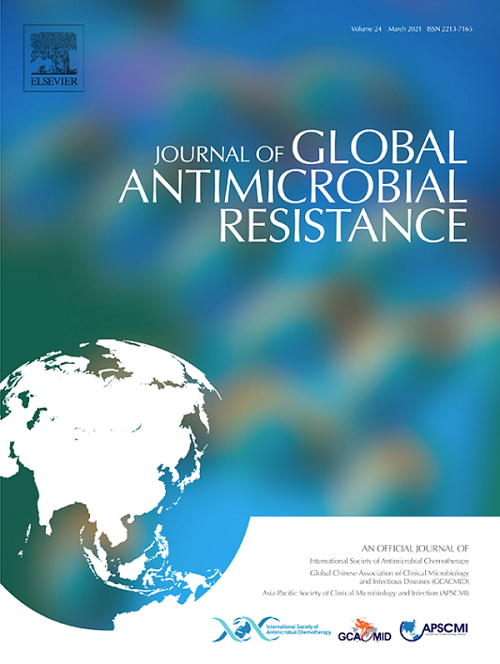In vitro activity of ceftolozane/tazobactam against ESBL-producing enterobacterales in China: SMART 2016–2019
IF 3.7
3区 医学
Q2 INFECTIOUS DISEASES
引用次数: 0
Abstract
Objectives
To evaluate the in vitro susceptibility of ESBL-producing Enterobacterales isolates to ceftolozane/tazobactam (C/T), a combination of tazobactam (a ß-lactamase inhibitor) and a new antipseudomonal cephalosporin.
Methods
From 2016 to 2019, susceptibilities of 10,545 Enterobacterales isolated from intra-abdominal, urinary tract, respiratory tract and bloodstream infections to C/T and 11 other antimicrobial agents were analyzed. Non-ESBL-producing isolates were included for comparative analysis to provide a comprehensive susceptibility profile.
Results
Among 10,545 isolated Enterobacterales, 54.6% were ESBL producers. The ESBL-positive rates for E. coli (4984/10,545, 47.3%) and K. pneumoniae (3606/10,545, 34.2%) were 59.8% and 51.1%, respectively. The susceptibility rate to C/T for all Enterobacterales was 79.5%. For E. coli and K. pneumoniae, the C/T susceptibilities were 89.3% and 68.0%, respectively. For non-ESBL-producing Enterobacterales, susceptibility to C/T was 99.5%. The susceptibility of non-carbapenem-resistant (CR) ESBL-producing Enterobacterales to C/T was 81.0%. The isolation rates of ESBL-positive and carbapenem-resistant Enterobacterales (CRE), CR-E. coli, and CR-K. pneumoniae were 14.3%, 5.6% and 26.8%, respectively. The susceptibility of ESBL-positive CREs to C/T was <20% for most antimicrobials except amikacin (50.4%). The susceptibility of ESBL-positive CR-E. coli to C/T was 28.2. For ESBL-producing CR-K. pneumoniae, susceptibility to most antimicrobials was <10%, except for amikacin (37.4%).
Conclusions
The present research underscores the viability of C/T as an alternative to carbapenems for the treatment of ESBL-producing, carbapenem susceptible Enterobacterales. However, the susceptibilities of ESBL-positive CRE to C/T and other studied antimicrobials were consistently below 20%, emphasizing for new innovative treatment strategies.
头孢唑烷/他唑巴坦对中国产esbl肠杆菌的体外活性:SMART 2016-2019 CE等级信息为2T。
目的:评价产esbl肠杆菌分离株对头孢唑烷/他唑巴坦(C/T)、他唑巴坦(ß-内酰胺酶抑制剂)与新型抗假单胞菌头孢菌素联合用药的体外敏感性。方法:分析2016 - 2019年腹腔、尿路、呼吸道和血流感染分离的10545株肠杆菌对C/T及其他11种抗菌药物的敏感性。不产生esbl的分离株被纳入比较分析,以提供全面的敏感性谱。结果:10545株分离肠杆菌中,产生ESBL的占54.6%;大肠杆菌(984/ 10545,47.3%)和肺炎克雷伯菌(3606 / 10545,34.2%)esbl阳性率分别为59.8%和51.1%。所有肠杆菌对C/T的敏感性为79.5%。大肠杆菌和肺炎克雷伯菌的C/T敏感性分别为89.3%和68.0%。对于不产生esbl的肠杆菌,对C/T的敏感性为99.5%。非碳青霉烯抗性(CR)产esbl肠杆菌对C/T的敏感性为81.0%。esbl阳性肠杆菌和耐碳青霉烯类肠杆菌(CRE)、CR-E。大肠杆菌和CR-K。肺炎分别为14.3%、5.6%和26.8%。esbl阳性cre对C/T的敏感性除阿米卡星(50.4%)外,大多数抗菌素的敏感性< 20%。esbl阳性CR-E的敏感性。大肠杆菌对C/T的比值为28.2。产生esbl的CR-K。肺炎类,除阿米卡星(37.4%)外,其余抗菌药物的敏感性均< 10%。结论:目前的研究强调了C/T作为碳青霉烯类药物治疗产esbl的碳青霉烯类敏感肠杆菌的可行性。然而,esbl阳性CRE对C/T和其他研究的抗微生物药物的敏感性始终低于20%,强调新的创新治疗策略。
本文章由计算机程序翻译,如有差异,请以英文原文为准。
求助全文
约1分钟内获得全文
求助全文
来源期刊

Journal of global antimicrobial resistance
INFECTIOUS DISEASES-PHARMACOLOGY & PHARMACY
CiteScore
8.70
自引率
2.20%
发文量
285
审稿时长
34 weeks
期刊介绍:
The Journal of Global Antimicrobial Resistance (JGAR) is a quarterly online journal run by an international Editorial Board that focuses on the global spread of antibiotic-resistant microbes.
JGAR is a dedicated journal for all professionals working in research, health care, the environment and animal infection control, aiming to track the resistance threat worldwide and provides a single voice devoted to antimicrobial resistance (AMR).
Featuring peer-reviewed and up to date research articles, reviews, short notes and hot topics JGAR covers the key topics related to antibacterial, antiviral, antifungal and antiparasitic resistance.
 求助内容:
求助内容: 应助结果提醒方式:
应助结果提醒方式:


